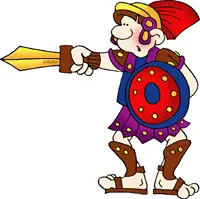Roman Slaves
Slavery in Ancient Rome:
Slavery was an important part of Roman society and culture. Romans, especially the rich ones depended greatly on their slaves for maintaining a luxurious lifestyle.
These slaves did most of the work for their masters and worked diligently to provide them comfort. Slaves in Rome were used for domestic help, manual labor, and gladiator fighting. Educated slaves were even employed as physicians, teachers, and poets.
Educated and skilled slaves carried a hefty price tag. Slaves made up a substantial part of the Roman population. In the 1st century BC, 30 to 40 percent of Italy’s population comprised of slaves.

Source of Recruitment
Most of the slaves were prisoners captured during the wars that Rome fought against other nations. These prisoners were then brought to Rome and sold off to a slave trader. The slave trader sold these slaves in either open auctions or private sales.
Slaves were acquired from all the wars Rome fought during the Republic and the imperial era. Each war fetched thousands of slaves. Romans recruited slaves from all regions without any regard for race. Most of these slaves belonged to Thrace, Gallia, Carthage, Britain, Syria, North Africa, and Germanic tribes.
Abandoned children were also used as slaves. Roman law allowed fathers to sell their adult children as slaves. This right was awarded by the founder of Rome, Romulus.
Legal Rights of a Slave
Roman law declared slaves as the personal property of their masters and did not accord them any legal rights. Slaves were not allowed to vote, hold a political office or claim any legal rights.
Some historians have written of brutal treatment meted out to the slaves by their masters. However, towards the later period of imperial Rome, reforms improved the plight of slaves and they were given many rights. Roman slaves could own property and in the later years of the Roman Empire, could even file a complaint against their masters.
Freed slaves were called ‘Libertus’. A slave could either be freed by his or her master in return of services rendered or he or she could buy their freedom from their own earnings. However, most of the slaves were not allowed to keep money.
The instances of slaves buying their freedom were very rare. All the children born to slaves were also considered slaves and were the property of their masters just like their parents. The children born to freed slaves were, however, considered free with the full rights of a Roman citizen.
Duties
Slaves possessing skills were greatly valued and were cared for. They were even employed as teachers and physicians. Some were employed as cooks in the households of rich Romans and were taken care of by their masters.
A domestic slave was expected to wake up early in the morning and start the hypocaust to warm up the room of his master. He then cleaned the house, washed clothes, worked in the kitchen to prepare meals, bathed and dressed their master and ran other errands.
Slaves with no skills were less fortunate and were made to work in mines, mills and fields. Their living conditions were poor and many of them died early. Condemned criminals and slaves punished for any offense were also sent to work in mines.
Some slaves were bought by owners of gladiator schools called ‘Lanistas’. They were then trained to become gladiators and fought in hugely popular gladiator games. Rich Romans could own hundreds of slaves who performed different duties. A typical Roman Emperor had close to 20,000 slaves at his service.
Slave Rebellions
A large number of former enemy soldiers were used as slaves. This naturally led to slave rebellions.
There were mainly three slave rebellions
- The First Servile War (135-132 BC)
- The Second Servile War (104-100 BC) and the most famous
- Third Servile war (73-71 BC) which was lead by a Thracian gladiator, Spartacus.



